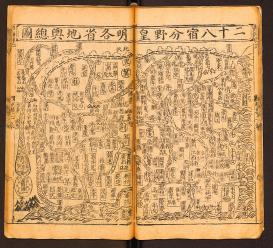This research is concerned with field allocation (fenye 分野) maps found across the popular Ming encyclopedias, beginning from the early seventeenth century. Field allocation is a system of relationships between terrestrial space, more precisely the territory of the Chinese imperial realm, and celestial space. A correlation is established between the units of administrative territorial divisions of the Chinese Empire and the twenty-eight lunar lodges (Ershiba xiu 二十八宿). The correlative cosmology is a well-known instrument of divination characteristic of the Chinese culture. Yet, the maps in question, despite being authentic visual sources on the earth-heavens correspondences, are often overlooked.
The main goals of the study are to trace the conceptual origins of the field allocation maps back to the early Chinese cosmography in all their complexity; to determine the reasons of the emergence of popular field allocation maps in the early seventeenth century and study their specific usage for divination; and, finally, to call attention to the evolution and a long-term after-life of the field-allocation type maps up to the early twentieth century equally overlooked in scholarly literature.

